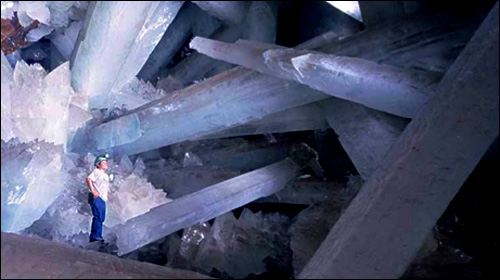Deep below the surface of the Earth in Mexico, in the Naica mine near a town called Delicia, lies the astonishing Cueva de los Cristales.
In 2000, two miners were excavating a tunnel for their employer Industrias Peñoles when they discovered this cavern crammed with naturally occurring crystals of selenite gypsum, some of which reach lengths of up to 11 metres (36 feet).
I’ve known about these caves for years, but was reminded of them yesterday when I stumbled upon the piece of video I’m embedding below. The temperature and humidity in the caves (which are critical conditions that allow the crystals to reach such an enormous size) are both extremely high. As you will see, this creates a few problems for a photographer.
Those crazy cavers! The reason that you can hear people calling out the elapsed time in the video, is that it is extremely dangerous for these guys to remain in the cave without breathing apparatus for more than about ten minutes. The temperature and humidity are so overwhelming that not only does condensation form on their camera lens, but also on the inside of their lungs. That doesn’t lead to a good outcome.
Selenite gypsum crystals are formed when calcium and sulphate molecules precipitate out of a solution of dissolved anhydrite. To create crystals of this immense size, the caves need to have stayed at very stable temperatures of around 58°C (136°F) for many hundreds of thousands of years.
The caverns remind me of one of my favourite childhood movies, The First Men in the Moon, based on a novel by H.G. Wells. The wonderful premise of this film (which was made 5 years before the first US moon landing) has a multinational mission landing on the moon in 1964 to find a British flag already planted there. This comes as something as a shock, needless to say. ((Perhaps not as much of a delicious shock as it might have been had the mission just been a NASA one!)) The astronauts go on to discover that the moon has already been visited more than half a century earlier by an eccentric English inventor and his companions.
Leaving contemporary events behind, the film flashes back to that first journey in 1899. Joseph Cavor and his associates, propelled to the moon in a fantastic capsule coated in an antigravity substance called ‘Cavorite’, discover an insect-like race living in great crystal-filled caverns under the surface. These creatures (called ‘Selenites’ coincidentally) become concerned that Earthlings, whom they discern to be warlike and aggressive, will follow Cavor to the Moon and destroy their world, and so they conspire to prevent the travellers from returning home…
The First Men in the Moon has to be one of the best proto-steampunk movies ever made. Here’s a (not very good quality) trailer off YouTube (the crystals appear mostly at the end of this clip):
I really would love for someone to remake this movie and keep it true to its original Victorian origins.
___________________________________________________________________________
Photograph of Cueva de los Cristales from National Geographic.
___________________________________________________________________________




